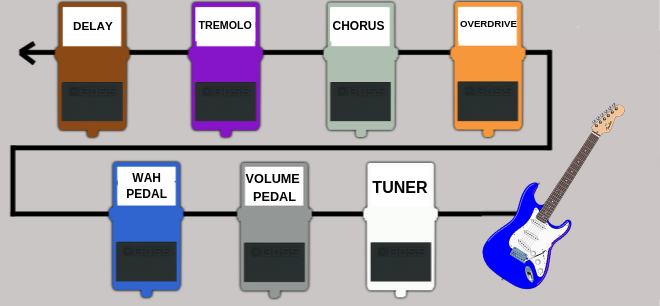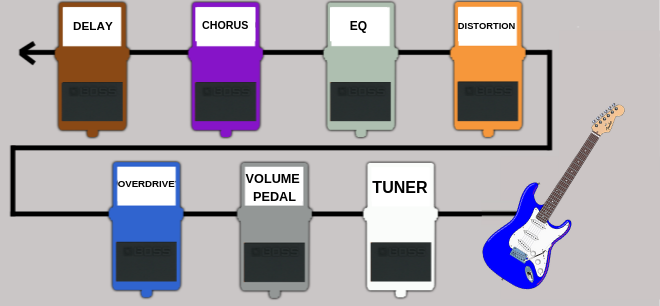How To Set Up A Wah Pedal
How To Set Up Your Pedalboard
The goal of your pedalboard is to:
- Have a logical layout that lets yous focus on your music and non on your pedals
- Create the right pedal order that reduces dissonance and hum
- Embellish tone and add graphic symbol, not destroy information technology
Logical Layout
Nearly guitarists have their effects laid out and connected from correct to left. The reason is that many standard size pedals have the input on the right side and output on the left. The right to left connections flow from pedal to pedal naturally.
BUT, y'all don't have to set up information technology up this style if it doesn't feel right. Experiment with it until you find the flow that suits yous!
Pedalboard Order Basics
An effective layout is based on optimizing your guitar's signal running through various furnishings, as well as including your own creative workflow and sound choices.
The most important affair to know is:
The society of your pedals makes a huge departure in your sound!
Some pedals work meliorate earlier in the chain, others better at the end. Getting this right solves many of the bug that can come up.
Though choosing the order of pedals in your pedalboard is part fine art and role scientific discipline, there are some time-tested chain layouts that forbid issues with incorrect pedal placement. Yous'll discover some popular sample chains after in this commodity.
That said, sometimes unique and artistic sounds come from breaking the rules.
So, if you're new to pedalboards, effort a time-tested layout first, and feel free to experiment afterward!
Tips and Guidelines On Pedal Gild Placement
The following tips and guidelines will help you understand the best order to put your furnishings pedals in a concatenation. The object is to produce nifty tone with minimal noise buildup.
- If you use a tuner, information technology should exist the outset pedal in the chain and then you lot can melody your guitar indicate without any effects. Yous tin can't effectively tune a guitar with delays or modulation effects turned on. Your guitar should exist plugged direct into the tuner.
- Pedals that help create your guitar's basic tone – like overdrive, distortion, wah, EQ – should come up before pedals that alter or change the audio, like chorus or phasers.
- Distortion/ overdrive units, wah pedals, and any other gain increasing effects tin potentially increment dissonance and/or amplify noise created by previous devices in the concatenation. They should fall towards the outset of the concatenation but before any filibuster/reverb devices.
- Time-based effects similar delay or reverb that create ambiance should exist at the end of the chain. Logically this makes sense as reverb and delay effects are produced naturally from sounds and are the last things you hear.
- Looper pedals should go at the very end, so the complete signal chain gets looped.
- A volume pedal can go either at the get-go or cease of the chain, with a different upshot created with each location. Experiment!
Guitar Tuner: In The Chain or Not?
Some purists don't like having a tuner in the chain, as they feel it adversely affects their tone.
But others love the ease of use that a tuner pedal brings.
At that place is no correct or wrong answer here; it'due south upward to your own personal preference. I find that having a tuner in my pedalboard is easier than having to connect to a split up one when I demand to tune up.
If you are concerned nearly loss of tone, there are tuner pedals bachelor that have a true featherbed manner. This manner bypasses all the pedal'due south circuitry and sends the input signal directly to the output jack without whatsoever loss of tone.
Also, some volume pedals have a tuner out jack that featherbed circuitry. Check those out as an culling.
Good Pedalboard Society Diagram
The following diagram illustrates a time-tested furnishings chain that follows a logical arrangement of furnishings. It'south designed to maximize tone and minimize noise.
Guitar -> Tuner -> Volume Pedal -> Dynamics -> Proceeds -> Modulation -> Time-Based -> Looper -> Amp

EFFECTS GUIDE
Dynamic Effects = Wah/ Compressor/ EQ
Gain Effects = Overdrive/ Baloney/ Fuzzbox
Modulation Effects = Chorus/ Flanger/ Tremolo
Time-Based Effects = Delay/ Reverb
Sample Pedalboard Lodge Chains
Here is a very popular pedalboard concatenation that provides lots of different audio options:
Guitar -> Tuner -> Volume Pedal -> Wah Pedal -> Overdrive -> Chorus -> Tremolo -> Delay -> Amp

The wah pedal tin can also be placed after the Overdrive for a dissimilar sound.
Another very constructive effects club concatenation:
Guitar -> Tuner -> Compressor -> Distortion -> Pitch Shifter > Delay -> Looper -> Amp

Many guitarists use compressors on clean tones to "fatten" the sound.
It'south common to disable the compressor when using baloney or overdrive as these sounds are by nature somewhat compressed.
Using pinch and distortion together also tin can issue in a lot of noise or hiss. But then again, lots of players swear by the increased sustain when using both. See what works for you!
Pedal club chain with EQ:
Guitar -> Tuner -> Book Pedal -> Overdrive -> Distortion -> EQ -> Chorus -> Delay -> Amp

EQ is added in this chain as a fashion to modify the guitar's tone and volume, particularly when used on solos to cut through amend.
Troubleshooting: Dealing With Noise Or Poor Sound Quality
If y'all end up with bug with racket, hum, hiss, or an overall deadening sound, the following sections tin help you lot fix the bug.
First, attempt this test: Plug your guitar straight into your amp, and then compare that sound with plugging into your pedalboard with all the pedals off. If the sound is noticeably different, and then the following solutions should assistance.
Dull Or Deadened Sound
Dull or deadened sound can be the result when many effects units and cables are connected together. Each effects unit and cable introduces capacitance, and this builds up as the bespeak travels through multiple units. Too much capacitance results in a poor overall guitar sound that's muddy, dark or muffled sounding.
True Bypass
Bypassing units using true featherbed jacks is one solution to the problem. True bypass simply means that the effect pedal can be switched to featherbed all circuitry.
Less circuitry = less capacitance.
If your effects offering true bypass, be sure to utilize them in that manner. Some pedals even provide truthful bypass mode when they are either off or on (fantastic!), only many older models do not.
Cables
Cables are an overlooked part of guitar playing. They are like an afterthought; many players just use the cheapest ones they can get. Merely cheap cables – especially the coiled types – can significantly increase capacitance and detract from your overall guitar tone.
So, the solution is to always utilise high-quality cables. And brand sure your connecting cables between effects pedals are as short as possible. You should hear an increase in sound quality equally well equally reduced racket.
Buffer Pedals
Buffer pedals are devices that can reduce the capacitance in the chain of effects, thus improving overall tone and sound.
The proficient news is that some manufacturer's event pedals are designed with and comprise buffer circuitry. The buffer may even be active when the pedal is bypassed, which is double skilful news.
Some tuners include a buffer, and some active guitar pickups (those powered by a battery) may include buffered circuitry.
Cheque the specs on your pedals to see if a buffer is included. Yous can also buy a specialized buffer pedal if needed.
Buffer Pedal Placement
There are a few places you can endeavor adding a standalone buffer pedal:
- In front of a long cable from your guitar to the pedalboard
- In front of low impedance effect like a fuzzbox
- At the end of the chain, from the pedalboard to your amp. As the terminal pedal in the chain is what feeds your amp, a standalone buffer pedal sometimes works best hither.
Experiment with these different placements to come across what improves your sound the most.
Noise
Too much racket or hiss can be fixed by reducing the capacitance, replacing low-quality cables with high-quality ones, and keeping your cables as short as possible.
If racket and hiss are still an issue, racket gate units are available to gate the signal when it drops below a certain threshold.
Advanced Pedal Use: Using Your Amp'southward Effects Loop
Some other lesser known but very cool mode to utilise your pedals is by incorporating them into your amplifier's effects loop.
What is an effects loop? An furnishings loop is just circuitry in your amp that allows you lot to send and render signals before the power amp section just after your amp'due south preamp. Some amps characterization the loop as Furnishings Send /Effects Return, or Power Amp In (Effects Return) / Preamp Out (Effects Ship).
The effects loop is most commonly used by guitarists who are using their amp itself to provide overdrive and distortion, not through their effect pedals. You usually cannot beat an overdriven tube amp for not bad tone, and using the furnishings loop on ane of these amps actually sounds smashing!
Not all amps, however, have effects loop circuitry, only if yours does, it can add additional flexibility to your guitar'southward audio.
Using Effects In An Effects Loop
The effects loop is unremarkably only used with delay and/or reverb effects that provide ambiance. It is not recommended for other types of effects.
What'southward the departure in audio between using the effects loop and just using the effects every bit usual?
If you utilize your amp'due south proceeds circuitry to provide distortion/overdrive, running your delay through the loop gives yous a brighter crisper sound – you tin hear the delays in much greater detail and clarity. Without using an amp's effects loop, running a distorted signal directly into a delay by and large results in a much muddier tone.
Series and Parallel Effects Loops
Depending on your amp, you may come up across series and parallel furnishings loop circuitry. The departure between them is how the betoken is candy.
With a series effects loop, the signal from the amp'south preamp passes direct from the furnishings send output to the furnishings pedal input and out from the pedal's output back into the furnishings render input.
Withal, parallel effects loop circuitry splits the effects and not-effects signal. Half of it goes from the preamp to the effects pedal and back into the amp. The other half goes straight to the amp's power amp section that has no effects.
A Mix control that lets you lot control the amount of upshot you hear.
Make sure you set the Mix command to 100% when using the effects loop.
How To Set Up A Wah Pedal,
Source: https://www.themusickitchen.com/accessories/guitar-pedalboard-setup-tips/
Posted by: ginyardoled1954.blogspot.com


0 Response to "How To Set Up A Wah Pedal"
Post a Comment